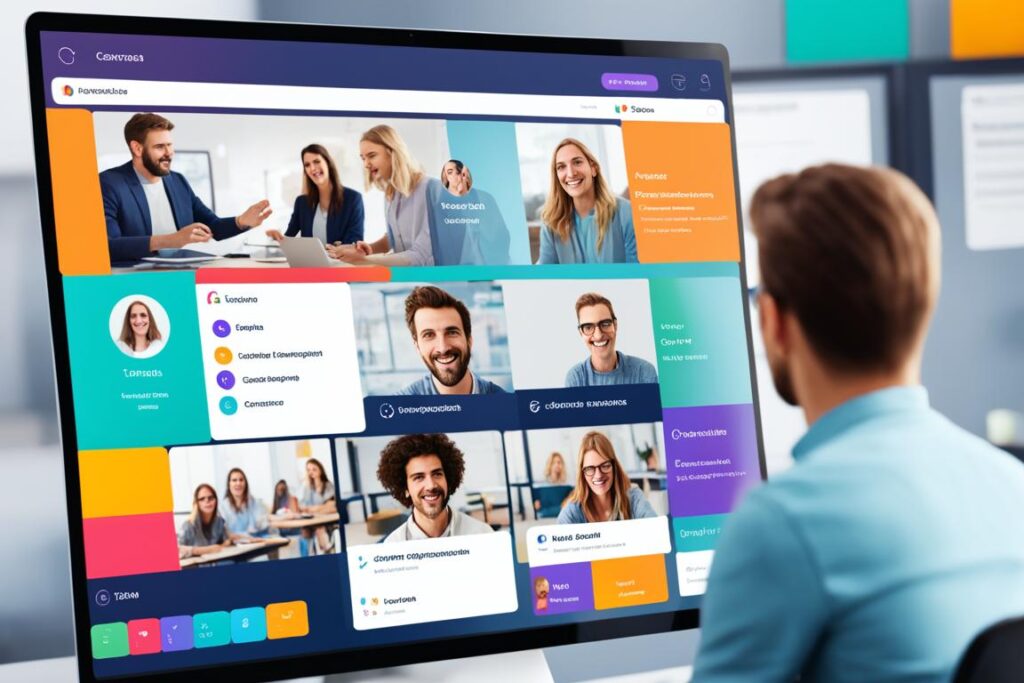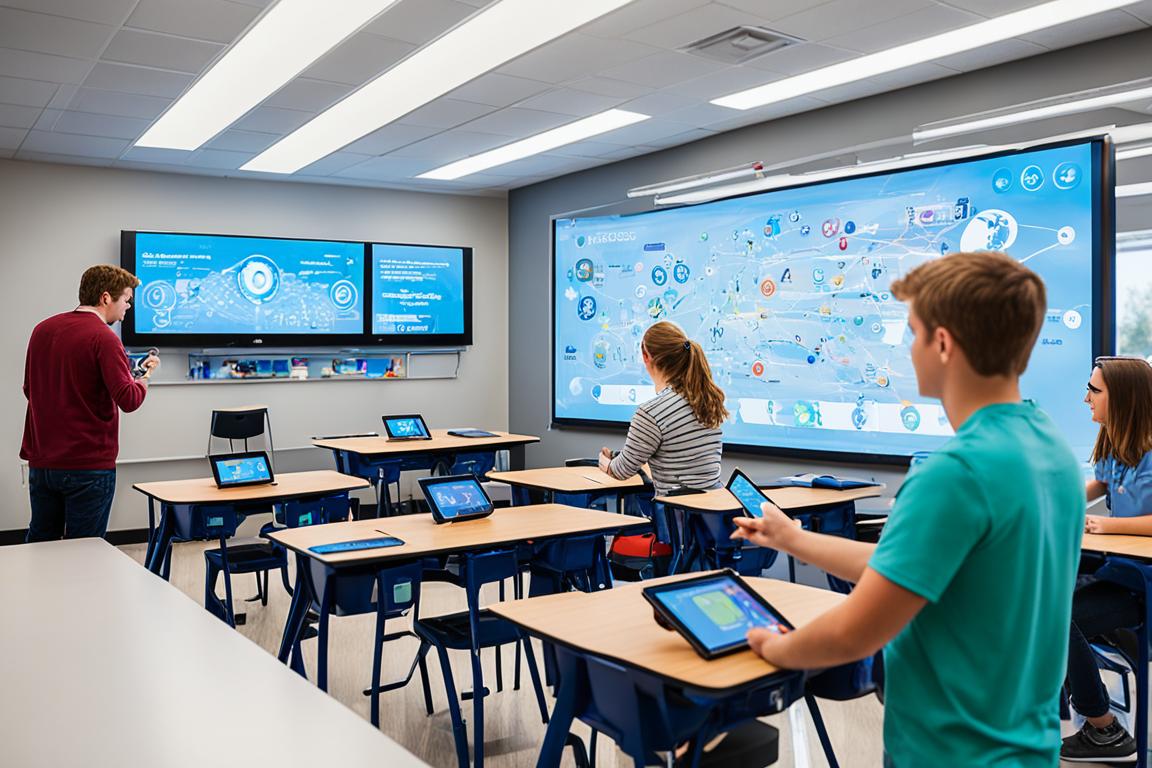In higher education, EdTech tools are key.1 They improve learning, simplify tasks, and boost student involvement. We’ll explore the best 30 EdTech tools for colleges and universities.2 This includes their main features, benefits, drawbacks, and how they change how we teach. ClassPoint is highlighted as the top pick for making lessons more interactive at a higher level.1
Key Takeaways
- Discover a comprehensive suite of innovative EdTech tools for higher education
- Explore cutting-edge features that enhance student engagement and learning experiences
- Learn about the pros and cons of leading EdTech platforms and their pricing options
- Discover how ClassPoint revolutionizes interactive presentations in the classroom
- Gain insights into the transformative potential of AI, immersive learning, and collaborative technologies in education
ClassPoint: Revolutionizing Interactive Presentations
ClassPoint is changing the game in educational technology, making teaching more engaging in higher education.3 It’s a part of Microsoft PowerPoint, making classes interactive and fun.4 It has Quiz Mode for fun quizzes, real-time notes, and leaderboards and badges to keep students interested.
Quiz Mode and Gamification
In Quiz Mode, teachers set questions for students to answer in class using their gadgets.3 With leaderboards and badges, students get more into the lessons.4
Pros and Cons
ClassPoint is praised for features like auto-grading and exportable data, plus fun games.4 But, its many features might need some training for beginners.4
Pricing Plans
ClassPoint has various plans for schools. There’s a free Basic, a Pro for $8/month, and a School plan that can be customized.4 This ensures teachers can find the right fit for their needs.4
How to Use ClassPoint in Higher Education
Teachers in college can use ClassPoint for quizzes, polls, and better presentations.3 It mixes with PowerPoint, so they don’t need other programs during class, making everything smoother.3
ClassPoint is easy to use and fits well with PowerPoint, aiding teachers.3 It makes learning more interactive, helps students meet their goals, and makes lessons more exciting.3 Students love how it makes lessons more engaging.3
Canvas LMS: Comprehensive Learning Management
In higher education, Canvas LMS stands out as a full-featured and flexible system. It’s designed to support many educational tasks and tools. This includes strong course management, learning resources, and a mobile app. All this makes it a first-rate choice for schools wanting a dynamic learning space.
Key Features
Canvas LMS offers a host of features perfect for higher ed needs. It has a customizable interface and is easy to use. Plus, it works well with multimedia and outside tools, helping teachers create and handle courses smoothly. Its app also keeps learning on track, letting students and teachers stay connected to course work anywhere.
Pros
Canvas LMS shines due to its flexibility and ease of use. It’s packed with features like learning resources and support for multimedia. This means teachers can make lessons engaging and complete. Its ability to work smoothly with many third-party apps and tools further boosts the learning experience.
Cons
Learning Canvas LMS can be challenging for new users because of its many features.5 Some may feel it’s too much to handle, especially those not used to such systems. They might find it hard to sift through all the options for customizing their experience.
Pricing Plans
Canvas LMS has pricing that fits various institutional budgets.6 Starting at $49 a month, it offers different plans to meet specific needs. This helps schools of all sizes find a plan that works for them.
Using Canvas LMS in Higher Education
Higher education teachers can use Canvas LMS to enhance their courses. They can add multimedia and lessons the way they want. The app helps keep learning going wherever students and teachers are. This makes for engaging classes and successful students.

Blackboard: Robust Course Management Platform
Blackboard is a top name in EdTech. It offers a strong Blackboard learning management system for high education. It aims to make learning better with a wide range of tools. These tools help in delivering online courses, managing content, and keeping students engaged.7
Key Features
Blackboard has cool features for course delivery and content management. It also has tools for assessment and analytics. Plus, there are features for working together and communicating. All of these help teachers create fun and effective worlds for their classes.7
Pros
Blackboard stands out for how it manages courses and grabs student interest. It’s loved for its good tools like assessment and analytics. That’s why many colleges and universities choose it.7
Cons
But, some say Blackboard needs a bit of learning to use well. And for some, the look and feel might not be so easy at first. Even so, it keeps a strong position in higher education.7
Pricing Plans
The cost of Blackboard isn’t shared with the public. Yet, a full package for a university or district might be about $160,000 yearly.7 This price might seem big, but the platform’s power often makes it a good buy for many schools.8
Zoom: Enabling Virtual Classrooms
Zoom is a go-to tool for virtual classrooms in higher education.9 It works well with systems like Blackboard and Canvas. This makes it easy for teachers to set up and run online classes. It offers a smooth experience for everyone involved.9
For higher education, Zoom has many useful features.9 It provides security features that help teachers keep their online classes safe. Teachers can use passcodes, limit access to certain users, and even lock meetings. This ensures a protected learning space.9
Another great thing about Zoom is its ability to create unique virtual spaces.9 It has Focus Mode for important exams and Immersive View for fun backgrounds with up to 25 people. This makes online learning more engaging and exciting.9
Zoom also focuses on making its platform accessible to all students.9 It includes things like keyboard shortcuts, screen reader support, and captioning. Live transcriptions and multi-pinning help meet different learning needs.9 Plus, they offer live training to help teachers make the most of Zoom’s features and connect with students in many ways.9
Arizona State University (ASU) and Zoom are working together to improve virtual classrooms.10 ASU is known as the most innovative university in America for eight years in a row by U.S. News and World Report. They’ve made a five-year commitment with Zoom. This includes creating the Zoom Innovation Lab.10 The lab will use ASU’s knowledge and technology team to build new online learning tools and spaces.10

Overall, Zoom’s many features, easy connections, and focus on serving everyone make it ideal for virtual classrooms.109
Khan Academy: Pioneer in Personalized Learning
Khan Academy is a leader in personalized learning. It has a vast collection of resources, interactive exercises, and covers many subjects. This allows students to follow their own path, learning at their own speed and focusing on their needs.
Sal Khan founded Khan Academy. He’s on TIME’s 100 Most Influential People list. The platform offers free knowledge to millions around the globe.
Initially, Khan Academy was a small project with 50 to 100,000 monthly users.11 Now classrooms in the U.S. welcome students from five to six grades, thanks to it.11 Many teachers use Khan Academy too, about half using it independently.11
Students love the help Khan Academy gives, especially those who thought they weren’t good at something. The platform uses videos and analytics to improve learning and find areas to focus on.12 By 2010, it grew to 40 staff members, with lots of software engineers on the team.12
Khan Academy stands out from others like edX, Udacity, and Coursera by keying in on personal learning. They aim to support, not replace, traditional education.12 In 2023, they introduced a new offering with OpenAI. This joint product acts like a teaching assistant or tutor, supporting learners online.11
| Feature | Description |
|---|---|
| Personalized Learning Pathways | Khan Academy’s platform lets students learn on their own. It provides tailored exercises to fill in knowledge gaps. |
| Comprehensive Subject Coverage | It covers a lot, from math and science to history and coding. This helps students explore different topics. |
| Self-Paced Learning | Students go through lessons when it suits them. This makes learning adjustable to personal schedules and preferences. |
| Analytics and Tracking | The platform tracks progress closely. It helps students see how they’re doing and where they can get better. |
Innovations in Education Technology
The world of educational technology is always growing. Innovative tools and platforms are changing how both students and teachers work. Things like virtual reality and AI-powered learning are really making a difference.13
Small learning startups are getting more popular. They offer easy, quick ways to learn. Since 2015, the number of these startups has gone up by 145%. This shows they’re meeting the needs of today’s students.13
Using AI in education is becoming a big deal. Sixty-three percent of teachers think AI will change education a lot in the next five years. It will bring more personalized learning and help teachers with better info.13
The market for Online Collaborative Learning Environments (OCLE) is growing a lot. It’s set to reach $3.8 billion by 2027. This shows how important working together online is becoming.13
Games are also being used more in education. It’s been found that training with games can help people remember up to 27% more. Adding fun, game-like aspects to learning could make it more engaging and successful.13
The future of higher education technology is exciting. New tools and platforms will keep changing how we learn. This will help students learn in better, more personal ways, preparing them for the future.13

Don Wettrick and StartEdUp: Pioneers in EdTech Innovation
Don Wettrick is the Innovation Coordinator at Noblesville High School. He is a leading figure in edtech innovation14. Wettrick’s aim is to empower students by creating a classroom where they can explore their interests. They get the chance to work on new ideas and even start their businesses.
Don Wettrick’s Journey
Wettrick started his journey to change education by noticing the need for a new approach.14 He has given talks on working together, starting your own business, using social media, and boosting innovation. These talks have taken him to places like the US and Europe.
Creating StartEdUp
His ideas led to StartEdUp, a network of teachers, innovators, and business-minded individuals united in changing education with tech14. StartEdUp is the world’s only network like this, bringing together experts with a shared goal of improving education.
Wettrick’s unique educational method got attention from other schools. They wanted to do what he was doing. He began sharing digital tools to help, cutting down on face-to-face training. He also started a podcast to reach more students interested in starting a business or sparking innovation.
Student Projects and Businesses
Wettrick’s classroom is where students can follow their passions, get advice from mentors, and work on impactful projects14. His students have started many different projects like NGOs, apps, events, and businesses. Wettrick tells his students it’s okay to fail, as they learn a lot from trying new things.
The StartEdUp Podcast
Wettrick is committed to bringing innovation into education, inside and outside the classroom. He runs the StartEdUp podcast. It features talks with education and business leaders, offering special insights in the sector14. Prized entrepreneurs like Daniel Pink and Gary Vaynerchuk have supported Wettrick and his students, enhancing the StartEdUp network.
Wettrick’s cutting-edge education model attracts attention from various experts, entrepreneurs, and leaders14. By enabling students to follow their passions, test new ideas, and create their businesses, Wettrick and StartEdUp are opening the door for the next EdTech innovators.
HPA Tech Retreat: Exploring Cutting-Edge Innovations
The HPA Tech Retreat brings together top leaders in engineering, tech, creativity, and business. They dive into exciting topics on how content is made, managed, and spread.15 This year, the event includes a golf tournament, networking, and expert-led sessions.15 It will all happen at the Westin Rancho Mirage Golf Resort & Spa, offering a deep dive into the future of media and entertainment tech. It aims to build connections and explore new tech trends.15
Overview of the HPA Tech Retreat
The week of February 16, 2025, marks the HPA Tech Retreat at The Westin Rancho Mirage. Sunday kicks off with a golf tournament and a welcome reception. The main sessions happen on Wednesday and Thursday.15 The Innovation Zone is buzzing from Monday to Wednesday, bringing tech and creativity together.15 Companies like Amazon, Apple, Disney, Microsoft, Netflix, and Sony will be there.15
Program Highlights
The event’s week is packed with activities. Monday features TR-X, focusing on “Extreme Production”.16 The main part is on Wednesday and Thursday. There’s also the Supersession on Tuesday, February 20, 2024.16 In previous years, super events included setting up 3D theaters for “Avatar: The Way of Water” and virtual production volumes.16
Featured Speakers and Topics
The 2024 Supersession will host sessions on advanced animation and AI filmmaking.16 A special morning session covers making the animated short film “Ashen”. The afternoon session looks into an AI-made animated film.16 The day ends with a panel talk involving both sessions.16 The event usually sells out quickly because of its limited number of spots.16
HPA Tech Retreat attracts key industry decision-makers. Sponsorship is open from companies in the entertainment and tech fields.15 Attendees can enjoy the relaxation lounge, resort activities, and the Innovation Zone cocktail reception. There’s also a food truck fest.15
AI’s Transformative Impact on Education
Artificial intelligence (AI) is changing education. It’s making both learning and teaching different.17 By 2030, the AI EdTech market could be worth $535 billion. This shows how big of a change AI can make.17 In 2021, a study found that AI games help students get more into learning. Another in 2020 showed how AI helps teach languages in a more personal way to a variety of students.
AI-Powered Learning Tools
AI technologies in education can predict student hurdles and better use resources to help them.17 Tools like reading software for visually impaired students show AI’s compassion for all learners.17 In 2021, most in the EdTech field said AI will make learning much better.17
Personalized Learning with AI
18 AI makes learning personal by studying each student closely. This lets teachers fit lessons to each student’s way of learning.18 With AI, we move from the same lesson for all to lessons that suit each student. It lets students learn at their own speed, matching their likes and how they learn best.
AI in Curriculum Design and Assessment
18 AI looks at the data to help teachers know how students are doing and what they need.18 Thanks to AI, grading work is easier for teachers. This lets them focus on more interactive lessons and helping students directly.18 AI also helps teachers keep learning about new ways to teach. It may change the role of teachers into more of a guide, focusing on supporting each student’s journey in a unique way.

Future of EdTech: Trends and Predictions
The future of education technology is set to change. It will focus on things like immersive learning, adaptive platforms, and tech that helps us learn together.19
Immersive Learning Experiences
Imagine learning with virtual and augmented reality. It will make lessons come alive, grabbing your attention and helping you remember more.20
Adaptive Learning Platforms
Platforms that can change to fit what you need are coming. They’ll know how best to teach you, using AI and tracking your progress.1920
Collaborative Learning Technologies
Working together will become even easier. New tech will make sharing knowledge among students and teachers a big part of learning.20
Conclusion
The world of education technology is changing fast. Now, there are many new tools and platforms for schools and teachers to use. These tools, like ClassPoint, Canvas LMS, and Blackboard, are making learning better.21 They help students get into the lesson more and make teaching easier.22 With new tech coming, like AI, virtual learning, and teamwork tools, school might look very different soon.21 Teachers can use these new tools to make learning more fun and useful. This way, students can get ready for jobs in the future.
Schools are welcoming more digital help, even as some kids leave public schools to learn at home.22 They now have computers and the internet for learning.22 The pandemic has also pushed teachers to get better with technology.22
In the future, focusing on new education tech is key, especially for colleges.21 Using the latest tech can help students get ready for the jobs waiting for them.23 This includes making learning more interesting and working together on projects21. Teachers will help by creating places where students want to learn and work together.
FAQ
What are the top EdTech tools for higher education?
What makes ClassPoint the best overall choice for revolutionizing interactive presentations in higher education?
What are the key features and benefits of using Canvas LMS in higher education?
What are the pros and cons of using Blackboard as a course management platform in higher education?
How can Zoom enable virtual classrooms in higher education?
How does Khan Academy revolutionize personalized learning in education?
How is artificial intelligence (AI) transforming the education landscape?
What are the future trends and predictions for education technology?
Source Links
- https://cxotoday.com/press-release/maxhub-unveils-a-paradigm-shift-in-education-with-the-innovative-ce-product-series/
- https://www.classpoint.io/blog/edtech-tools-for-higher-education
- https://www.classpoint.io/blog/muhd-iqbal-makmur-classroom-response-system
- https://www.classpoint.io/blog/category/edtech
- https://ohiostate.pressbooks.pub/drivechange/chapter/the-evolution-and-diffusion-of-learning-management-systems-the-case-of-canvas-lms/
- https://balastechnologies.com/education-canvas-lms/
- https://en.wikipedia.org/wiki/Blackboard_Inc.
- https://www.k12digest.com/blackboard-a-trusted-technology-partner-for-global-education-community/
- https://www.zoom.com/en/industry/education/resources/educator-guide/
- https://news.zoom.us/asu-and-zoom-partner-to-transform-the-campus-experience/
- https://www.ted.com/podcasts/rethinking-with-adam-grant/khan-academy-founder-sal-khan-on-ai-and-the-future-of-education-transcript
- https://www.forbes.com/sites/peterhigh/2014/01/06/salman-khan-the-most-influential-person-in-education-technology/
- https://meetaverse.com/blog/top-innovations-in-education/
- https://www.reimagine-education.com/19-endorsed-entrepreneurs-safe-place-fail/
- https://hpaonline.com/event/2025-hpa-tech-retreat/
- https://hpaonline.com/hpa-tech-retreat-2024-unveils-groundbreaking-supersession/
- https://www.techuz.com/blog/how-ai-is-transforming-the-educational-technology-edtech-industry/
- https://www.eschoolnews.com/digital-learning/2024/02/05/impact-of-artificial-intelligence-in-education/
- https://www.thefuturelist.com/the-future-of-edtech-in-2024-unveiling-trends-and-transformations
- https://technews180.com/blog/edtech-trends-2024
- https://www.eschoolnews.com/it-leadership/2023/12/11/the-impact-of-technology-on-education/
- https://www.thepolicycircle.org/brief/innovation/
- https://www.educause.edu/ecar/research-publications/ecar-study-of-undergraduate-students-and-information-technology/2018/conclusion-and-recommendations
